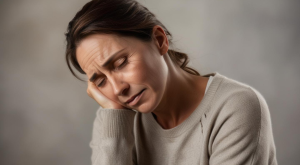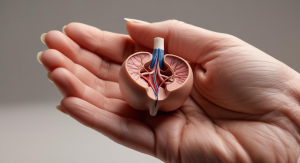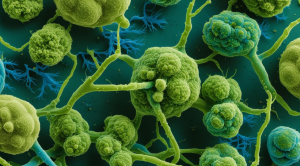Reducing your exposure to toxins can be challenging, and questions about the safety of your hair dye might not be the first thing on your mind. You may have already made strides by switching to organic, natural foods and replacing harmful household cleaners. Next, you’ve tackled your daily hair care, skincare routine, cosmetic products, and personal care products, clearing out anything questionable. But when it’s time to book your next hair appointment, you might wonder, “Is hair dye safe?”
What Causes Hair to Gray?
First, why does our hair go gray in the first place – especially when we’re still in our 20s or 30s? Well, it can be a combination of factors. Genetics do play a significant role in when and how quickly you go gray. Some people experience graying in their 20s, while others may retain their natural hair color well into their 50s or 60s. [1]
However, hair color is ultimately determined by specialized cells called melanocytes, which produce melanin in the hair follicles. As you age, these cells gradually produce less melanin, causing hair to appear lighter and eventually gray or white. Melanin production relies on enzymes like tyrosinase (melanin comes from the amino acid tyrosine). With age, these enzymes become less active, further decreasing melanin production. [2][3]
What speeds up the aging process? Oxidative stress. [4] Dietary and lifestyle factors like UV exposure, smoking, chronic stress, and pollution can damage these melanocytes, potentially speeding up the graying process. Nutritional deficiencies and health conditions can also contribute. A vitamin B12 deficiency or thyroid condition can also lead to premature graying. [5][6]
As part of the aging process, or due to oxidative stress, hair follicles accumulate hydrogen peroxide, a natural byproduct of metabolism that’s also a known bleaching agent. This build-up can bleach the hair from the inside out, contributing to color loss. [7]
Is Hair Dye Safe?
We wish we could give you better news, but deep down, you probably already knew that hair dye wasn’t entirely safe. After all, that’s why you asked the question! If you’ve been using permanent hair dyes, it’s essential to know that a completely toxin-free option doesn’t even exist. (Even henna can have chemical additives.) [8]
Of all the beauty products out there, hair dye comes with the most health and safety risks. Your scalp is highly absorbent, and the chemicals applied to it can get absorbed into your bloodstream, traveling throughout your body and potentially causing harm. We get it—it’s hard to hear. Many of us strive for a natural lifestyle but aren’t quite ready to give up polished, vibrant hair.
Unfortunately, hair dye formulations often contain hundreds of chemicals linked to serious health concerns, including hormone disruption, increased cancer risk, asthma, allergic reactions, and autoimmune disease. Some epidemiologic studies even suggest a connection between hair dye users and the risk of breast cancer, bladder cancer, and liver disease. [9][10][11] The risks increase with frequent use, and hairdressers are at an even greater danger.
In fact, the International Agency for Research on Cancer (IARC) has determined that workplace exposure to chemicals used by hairdressers is “probably carcinogenic to humans.” [12] It makes a difference what type of dye is used. There are temporary dyes, semi-permanent dyes, and permanent hair dyes. Each category uses a different process and has different chemical ingredients.
Hair straighteners and relaxers also have health risks due to the frequent presence of formaldehyde. Black women are more likely to use these products.
The problem with testing the safety of hair color is that there are many different types of hair dyes and formulas, and the risks are compounded by other factors. Nobody knows how harmful these chemicals truly are to our health.
Is the Risk of Hair Dye Worth It?
There might be safer hair color alternatives, but coloring your hair isn’t a totally risk-free process. The process of coloring your hair isn’t usually both gentle and effective. Chemicals like the aromatic amine paraphenylenediamine (PPD or PPDA), toluene, and resorcinol are often a part of getting the job done. [13] Lead acetate was previously used in hair dye, but the FDA no longer allows it due to safety issues. [14]
According to Poison Control, permanent colors contain an alkalizing chemical like ammonia that penetrates the hair shaft so the color can adhere better. Then, additional ingredients cause chemical reactions that generate color molecules inside the hair shaft. [15]
Using permanent hair dye chemicals also comes with a risk of hair loss. Dermatologists have been concerned about this for years, along with the risk of allergic reactions to the dye ingredients. [16]
So far, those potential risks have been ignored. A 2008 survey done by Clairol found that 3 out of 4 women color their hair and that 88 percent of women felt their hair affected their confidence. [17] Since then, the hair color market has been growing and not slowing down. Some of us have been coloring our hair for so long that we have forgotten its original color.
So, how can you reduce the risks associated with hair dye? If you dye your hair yourself at home, there are a few things you can do to reduce your exposure to chemicals or avoid allergic reactions:
- Wear gloves when mixing or applying the dye.
- Conduct a patch test on your skin to check for skin irritation before applying it to your scalp.
- Follow instructions, and don’t leave the dye on your hair longer than recommended.
- Never mix different formations, as you don’t know what chemical reactions you could create.
- Don’t use hair dye to tint your eyelashes or eyebrows, as it could permanently damage your eyes.
There are safer options and what we like to consider shades of crunchiness. Just because you aren’t willing to totally give up your personal use of hair dyes doesn’t mean there aren’t safer alternatives. We all have to start somewhere, and being healthier means taking steps in the right direction. Below are a few of our suggestions, beginning with the safest hair color options and then moving to the less crunchy options.
Shades of Crunchiness: What Are Safer Hair Dye Alternatives?
You don’t have to succumb to the pressure and dye your hair to cover the gray. There are alternatives, including the option to do nothing and embrace your crown of glory.
1 – Let Your Hair Go Natural
The safest and easiest option is to go natural. We joke about looking crunchy, but everyone has beautiful hair. Some women are dying to have your natural hair color. Look at the color swatches your stylist has– your color is there. Are you already going gray? Embrace it! There is a whole movement of women who are going gray. Letting your hair color go natural is the easiest and healthiest option. If you’re currently dealing with health problems or are trying to detox – skip the hair color. Hair dye isn’t worth the exposure to carcinogens!
2 – Ask for Hair Coloring Products Without PPD
Not ready to give up your visits to the salon? Talk to your stylist and ask them if their hair dye is safe. Request a color that doesn’t have para-phenylenediamine (p-phenylenediamine ), one of the most common cancer-causing hair color ingredients.
It’s also safer to go lighter rather than darker. The darker color options have higher levels of PPD and the chemical resorcinol, a known endocrine disruptor. [18]
The U.S. Food and Drug Administration (FDA) doesn’t closely regulate PPD and other coal-tar colorants.
These chemicals are listed in the Food Drug and Cosmetics Act as exempt from cosmetic regulations as long as the hair dye has a caution label and warning to do a skin test first. [14]
3 – Use Natural Hair Dye Alternatives
Did you ever put lemon juice on your hair and sit in the sun for natural highlights? There are natural hair dye alternatives that don’t require a box. Lemon and chamomile are excellent for lightening your hair. Coffee, tea, sage, rosemary, and henna can help you maintain dark hair. Beet juice and carrot juice can add red undertones to your hair if it’s light.
These natural hair dye alternatives can take longer to apply and don’t last as long, but they come without the risk factors—unless you’re allergic to lemons or beets. Always avoid your food allergies.
4 – Try Hairprint to Restore Your Natural Hair Color
Are you not ready to embrace the gray and just want your original hair color back? There’s a highly recommended hair dye product called Hairprint True Color Restorer. It’s not a hair color, but it can eliminate your gray. It’s a protein treatment that puts melanin back into your hair, restoring your natural hair color. There are no toxins, just proteins. Some say it’s safe enough to eat, but we’ll pass.
Remember, even the safer hair dyes have chemicals in them if they are permanent. No matter how many organic oils and exotic-sounding plants they throw in your hair dye, some risky chemicals remain. Get foils instead of an all-over color to minimize how many chemicals enter your bloodstream. By reducing the amount of chemicals that touch your scalp, you reduce the amount that makes it to your bloodstream.
Reduce Your Toxin Exposure – We Can Help!
Now you know the answer to the question, “Is hair dye safe?” It might not be the answer we were looking for, but by understanding the increased risks of coloring your hair, you can take steps to choose safer hair color alternatives. You get to choose what shade of crunchy you choose as you build a healthy life. No matter which shade(s) you choose, don’t think of it as giving up something. It’s a lifestyle upgrade that will make you more beautiful inside and out. The only thing you will be giving up is extra toxins. Need guidance on reducing your toxic load? Reach out to a Wellness Way clinic today!
References:
1.Association of premature hair graying with family history, smoking, and obesity: a cross-sectional study – PubMed
2. Reversing Gray Hair: Inspiring the Development of New Therapies Through Research on Hair Pigmentation and Re-pigmentation Progress – PMC
3. Melanin and lipofuscin as hallmarks of skin aging – PMC
4. Towards a “free radical theory of graying”: melanocyte apoptosis in the aging human hair follicle is an indicator of oxidative stress induced tissue damage – PubMed
5. A Clinical Study of Premature Canities and Its Association with Hemoglobin, Ferritin and Calcium Levels – PubMed
6.Premature Graying of Hair: A Comprehensive Review and Recent Insights – PMC
7. Age-induced hair greying – the multiple effects of oxidative stress – PubMed
8. Determination of para-Phenylenediamine (PPD) in Henna in the United Arab Emirates – PMC
9. Hormonal contraceptives and hair dyes increase breast cancer risk | ScienceDaily
10. Use of permanent hair dyes and bladder-cancer risk – PubMed
11. Case–control studies of risk factors for primary biliary cirrhosis in two United Kingdom populations | Gut
12.IARC Publications Website – Some Aromatic Amines, Organic Dyes, and Related Exposures
13.Hair Dye Ingredients and Potential Health Risks from Exposure to Hair Dyeing – PMC
14.Hair Dyes | FDA
15.Concern about Hair Dye | Poison Control
16.Hair Dye Ingredients and Potential Health Risks from Exposure to Hair Dyeing – PMC
17.To dye or not to dye | Emerita
18. Para-phenylenediamine allergy: current perspectives on diagnosis and management – PMC





